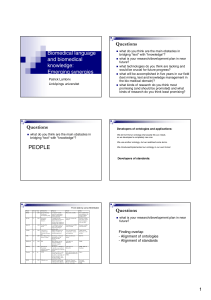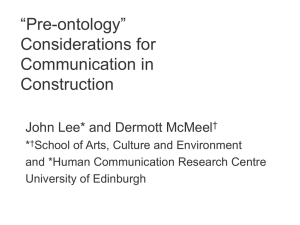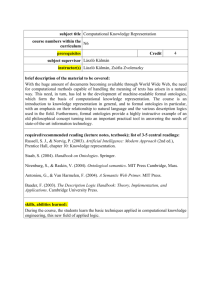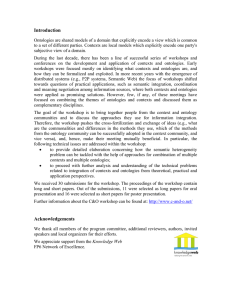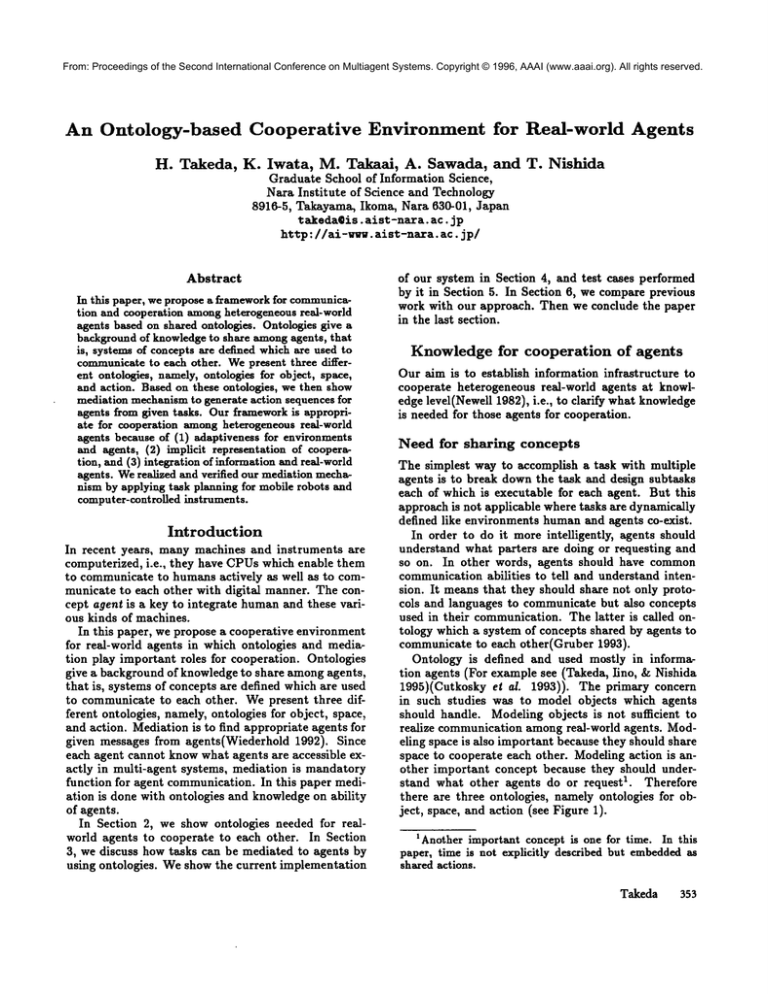
From: Proceedings of the Second International Conference on Multiagent Systems. Copyright © 1996, AAAI (www.aaai.org). All rights reserved.
An Ontology-based
Cooperative
Environment
for
Real-world
Agents
H. Takeda, K. Iwata, M. Takaai, A. Sawada, and T. Nishida
Graduate School of Information Science,
Nara Institute of Science and Technology
8916-5, Takayama, Ikoma, Nara 630-01, Japan
t aEeda@is,
aist-nara,
ac. jp
http://ai-...,
aist-nara,
ac. jp/
Abstract
In this paper, we propose a frameworkfor communication and cooperation amongheterogeneous real-world
agents based on shared ontologies. Ontologies give a
backgroundof knowledgeto share amongagents, that
is, systems of concepts are defined which are used to
communicateto each other. Wepresent three different ontolagies, namely, ontologies for object, space,
and action. Based on these ontologies, we then show
mediation mechanismto generate action sequences for
agents from given tasks. Our frameworkis appropriate for cooperation amongheterogeneous real-world
agents because of (1) adaptiveness for environments
and agents, (2) implicit representation of cooperation, and (3) integration of information and real-world
agents. Werealized and verified our mediation mechanism by applying task planning for mobile robots and
computer-controlled instruments.
Introduction
In recent years, many machines and instruments are
computerized, i.e., they have CPUswhich enable them
to communicate to humans actively as well as to communicate to each other with digital manner. The concept agent is a key to integrate humanand these various kinds of machines.
In this paper, we propose a cooperative environment
for real-world agents in which ontologies and mediation play important roles for cooperation. Ontologies
give a background of knowledge to share amongagents,
that is, systems of concepts are defined which are used
to communicate to each other. Wepresent three different ontologies, namely, ontologies for object, space,
and action. Mediation is to find appropriate agents for
given messages from agents(Wiederhold 1992). Since
each agent cannot knowwhat agents axe accessible exactly in multi-agent systems, mediation is mandatory
function for agent communication. In this paper mediation is done with ontologies and knowledgeon ability
of agents.
In Section 2, we show ontologies needed for realworld agents to cooperate to each other. In Section
3, we discuss how tasks can be mediated to agents by
using ontologies. Weshow the current implementation
of our system in Section 4, and test cases performed
by it in Section 5. In Section 6, we compare previous
work with our approach. Then we conclude the paper
in the last section.
Knowledgefor cooperation of agents
Our aim is to establish information infrastructure to
cooperate heterogeneous real-world agents at knowledge level(Newell 1982), i.e., to clarify what knowledge
is needed for those agents for cooperation.
Need for
sharing
concepts
The simplest way to accomplish a task with multiple
agents is to break downthe task and design subtasks
each of which is executable for each agent. But this
approach is not applicable where tasks are dynamically
defined like environments humanand agents co-exist.
In order to do it more inteUigently, agents should
understand what patters are doing or requesting and
so on. In other words, agents should have common
communicationabilities to tell and understand intension. It means that they should share not only protocols and languages to communicate but also concepts
used in their communication. The latter is called ontology which a system of concepts shared by agents to
communicate to each other(Gruber 1993).
Ontology is defined and used mostly in information agents (For example see (Takeda, lino, & Nishida
1995)(Cutkosky et al. 1993)). The primary concern
in such studies was to model objects which agents
should handle. Modeling objects is not sufficient to
realize communication among real-world agents. Modeling space is also important because they should share
space to cooperate each other. Modeling action is another important concept because they should understand what other agents do or request 1. Therefore
there are three ontologies, namely ontologies for object, space, and action (see Figure 1).
1Another important concept is one for time. In this
paper, time is not explicitly described but embeddedas
shared actions.
Takeda
353
From: Proceedings of the Second International Conference on Multiagent Systems. Copyright © 1996, AAAI (www.aaai.org). All rights reserved.
(a)Knowledge
on object
(b)Knowledge
on space
(c)Knowledge
on action
Figure 1: Three types of concepts
Figure 2: An example for object ontology
Concept for object
The environments are usually fulfilled with a lot of objects, and tasks are usually related to some of these
objects. They should share concepts for objects, otherwise they cannot tell what they recognize or handle
to other agents.
Difficulty lies that what they can understand are different because the way they can perceive are different.
It depends on abilities for sensing, acting, and information processing.
Agents should understand objects to communicate
to each other, but a number and kinds of objects may
be different. Attributes of objects agents can understand are also different because they should be directly
or indirectly associated to attributes which can be detected by agents’ sensors.
The policy for making shared concepts is using abstraction levels to represent objects. W’ebuild taxonomyof objects as hierarchy of ia-a relations. Figure
2 shows an example of this ontology which represent
objects in workshop. It does not mean that all agents
can understand all objects in this figure. Most agents
can only understand subsets of those objects because
recognition abilities are limited. For example, some
agent can recognize a box but cannot recognize difference between a trash box and a parts-case, because it
can only detect whether it is a box or not. It is sufficient for this agent to understand concept boz and its
higher concepts.
Weprovide current position, default position, color,
weight for attributes which are commonfor all objects.
Descriptions of attributes have also levels of abstraction. For example, in most abstract description of
weight, there are only three values, i.e., light, middle,
354 ICMAS-96
and heavy. In other abstract level, it can be represented by more symbols, or numerically. The level of
abstraction is determined by abilities of sensing and
pattern recognition.
Concept
for
space
The next important concept for cooperation is concept
for space. Since agents are working in the physical
world, they should understand space, that is: where
they are, where they are moving for, where the target
object exists, and so on. Especially it is important
for agents to work together. According to sensing and
processing abilities of agents, they can have differen!
ways to represent space. For example, agents which
move by programmed paths would represent space by
paths and points to stop. Some agents cannot have
absolute positions but relative position.
Weprovide the following two types of representation
as shared space ontology.
Representation
with preposition
Relative position is described as combination of preposition
and object which is represented as object ontology(Herkovits 1986). Weprovide seven prepositions,
i.e., at, on, in, in-front-of, behind, to-the-right-of,
and to-the-left-of.
For example, a position in front
of the rack agent is represented as in-front-o~
(rack-agent).
Actual position is determined
agents who interpret representation.
Representation
with action l~elative
position
can be also represented by action. For example, it
From: Proceedings of the Second International Conference on Multiagent Systems. Copyright © 1996, AAAI (www.aaai.org). All rights reserved.
((<action-name>
(<attribute-name>
<attribute-value>)
(<attribute-name>
<attribute-value>)
,.,)
(<constraints
among
attributes>)
(<decomposed-action-name>
(<attribute-name>
<attribute-value>)
(<attribute-name>
<attribute-value>)
,,.)
(<decomposed-ection-name>
...)
)
Figure 3: Syntax for action concept
is useful for agents who want to achieve action to describe space as "where you can look at the rack" or
"where you can meet Agent X." The actual position
may be different according to which agent would take
action, because ability of action agent can do may be
different. No matter actual position differs, it is sufficient to understand positions where such action can
be done.
We describe position with combination of an
action-related
term and object(s).
For example,
viewpoint(rack)
means a position where the agent
can look at the rack, and meetingpoint(agen¢l,
agent2) means where agent1 and agent2 can meet.
Concept
for
action
The last category for shared concepts is concept for action. Agents should understand what the other agents
are doing in order to cooperate with them. Like the
other categories, concepts which an agent can understand are also different according to ability of the agent
itself, in particular concepts which are directly associated to its physical action. But more abstract concepts
can be shared among agents. Concepts associated to
agents’ physical actions should be related to more abstract concepts shared by them in order to understand
each other.
In this paper, we provide nine primitive actions,
i.e., move, grasp, release, find, hold, open, close,
h_handover, and r_handover. ILhandover means the
action to hand object someone, and r_handover means
the action to receive objects handed from someone.
Definition of concept for action consists of name,
attributes like subject and starting-point,
and constraints amongattributes. Constraints are represented
as sharing of attribute values. Relation among concepts is decompositionrelation, i.e., an action can have
an sequence
of actionwhichcanachievetheoriginal
action.
Relation
amongdecomposed
actions
arerepresentedas constraints
amongattributes.
Figure3 shows
syntax
fordefinition
of actionconcepts,
andFigure
4
showsan example
of definition
of actionconcept.
((fetch (object ?object-I)
(from_place(on ?piece-2))
(to_place (on ?piece-3))
(subject ?agent-4))
(at ?agent-4))
(from
(in_frontof?place-3)))
(to
((- (on?piece-2)
(:current-place
?object-I)))
(move(subject
?agent-4)
(from
(at
?piece-4))
(in_fronLol?piece-2)))
(to
(bring(object
?object-I)
(from_place(on
?piece-2))
(to_place ?place-3)
(subject ?agent-4)
?agent-4)
(from
(at
(in_fronLof?piece-3))))
(to
Figure 4: An example of action concept
Mediation
In thissection,
we discusshowto realizecommunicationamongagentswithdifferent
ontologies.
We
introduce
mediators
whichbreakdownand translate
tasksto be ableto understand
agents(Takeda,
ling,
Nishida 1995). In this paper, we assume that tasks are
given as actions by human.
The function of mediators is to bridge a gap between
tasks specified by human and actions which can be
done by agents. Since in most cases, tasks should be
performed by multiple agents, tasks are decomposed
into subtasks to distribute to agents. Ontologies have
two roles in this process. Firstly, it is used to understand the given tasks. Since given tasks are what
humanswant agents to do, they are insufficient and incomplete for specifying a sequence of actions. Ontologies supply information on environments and agents
to complete task descriptions. Secondly, it is used to
distribute tasks to agents. As we mentioned in the previous section, each agent has its own ontology which
is dependent to their physical and information ability.
But shared ontologies integrate these agent ontologies
using abstraction. Tasks can be translated to a set
of local tasks each of which is understandable by some
agent by using multiple abstraction levels in ontologies.
Weprovide four processes to process the given tasks
in mediation (see Figure 5.
Supplement of object attributes
If necessary attributes of objects are missing in a task description,
the mediator can add these attributes using default
values in object ontology.
Assignment of agents The mediator assigns agents
to perform actions to realize the task. It is done
by consulting knowledgeon agent abilities which is
represented by object, space, and action ontologies.
Action decomposition
The mediator decomposes
the given action into actions each of which can be executable by some agents. Decomposition of action is
Takeda
355
From: Proceedings of the Second International Conference on Multiagent Systems. Copyright © 1996, AAAI (www.aaai.org). All rights reserved.
J Supplement
of object attributesJ ~
Action decomposition~
/ Action
knowledge C’I,,._~
Aclionontology~
Idec°mp°siti°nJ
I-JLI
°fAgents
I
T Assignment J
[ Translationinto local ontologyI
ObjectDB
Objectontology
Knowledge
on
~J~gents
e, bilities
/ Space
ontology
L Action
ontology
Figure 5: Mediation flow
done by consulting action ontology. Action decomposition and agent assignment are done simultaneously because action decomposition restricts agent
assignment and vice versa.
Translation into local ontology All
information before this process is represented by the
shared ontologies. Before sending out the decomposed messages to agents, the mediator translates
each message into one in the local ontology to the
receiver agent.
Implementation
of
Mediators
In this section, we show our preliminary implementation of agents and mediators. Characteristics of our
implementation is to use techniques for information
agents to both agents and mediators discussed in Ref.
(Takeda, Iino, & Nishida 1995).
Types of real-world
agents
Weused four different real-world agents to demonstrate our approach. Two of them are mobile robots
and the others are computer-controlled machines.
Mobile Agent Kappala: Kappala is a mobile robot
which has a stereo CCDcamera with two rotational
freedoms, and two six-freedom manipulators with
hands (see Figure 6). There are two modes for navigation. One is map-based navigation in which the
robot can movealong with predefined paths and stop
at predefined stopping points. In this mode, the
robot can avoid obstacles automatically. The other
is direct operation in which commandslike move,
stop, and turn are directly executed. The manipulators are operated either by tele-operating or by
commands.There are an infrared radar and eighteen
supersonic sensors. There is an on-board computer
with a wireless Ethernet. It has interfaces for all actuators and sensors and an interface for TCP/IP by
which it can comnmnicate to other on-board computers and Unix computers on the network.
Mobile Agent Kappalb Kappalb is the same to
Kappala except no manipulators are equipped.
356
ICMAS-96
Computer-controlled
Rack It is an automated
rack which can store and take out objects by commandin computers (see Figure 7 ).
Computer-controlleddoor
It is an automated
door system which can open and close by command
in computers.
Agentification
Those robots and machines are agentified as KQML
agents(Finin et al. 1994). KQML(KnowledgeQuery
and Manipulation Language) is a protocol for exchanging information and knowledge among agents. KQML
is mainly designed for knowledgesharing through agent
communication. A KQML
message consists of a message type called performative like ask, tell and subscribe, and a number of parameters like sender, receit, er, content and language. For example, a message content is written as a value of parameter content. ~e mostly use KIF (Knowledge Interchange Forinat)(Genesereth & Fikes 1992) as language to describe
message contents. KIF is a language for interchange of
knowledgeand based on the first-order predicate logic.
Each robot or machine agent consists of three
sub-agents, namely KQMLhandling sub-agent which
parses and generate KQML
messages, database subagent which holds status of agent itself and environments, and hardwarecontrolling sub-agent which sends
commandsto actuators and to obtain sensor values.
Weprovide some pure information agents also as
KQML
agents to offer information processing to those
real-world agents. Image processing agent receives an
images and a color name, and an answcr where the
color is located in the image. User-interface agent accepts users’ queries and returns the results. Object
database agent manages information on objects’ attributes like positions based on object ontology, and
the content is updated by messages from other agents.
Implementation
of mediator
A mediator is implemented as two agents, namely, a
planner and a translator. The planner performs the
first three processes listed in Section 3.
From: Proceedings of the Second International Conference on Multiagent Systems. Copyright © 1996, AAAI (www.aaai.org). All rights reserved.
Figure 6: Appearance of Mobile Agent Kappala
Figure 7: Appearance of the computer-controlled rack
Supplement of object attributes is realized by consuiting the object database agent. Decomposition of
actions and assignment of agents are invoked recursively. First the mediator tries to find an agent which
can execute the given action by consulting knowledge
on agents’ abilities which is represented with object,
space, and action ontologies. If it find an agent, then
this process is terminated. Otherwise, it tries to decompose the given action by consulting action ontology. The decomposed actions are associated to each
other by sharing their parameters. Then again the
mediator tries to find agents which can execute each
action. If assignmentof agents for all actions are determined, the the current sequence of actions is a solution.
Iteration of decomposition and assignment is repeated
until all actions are assigned to agents.
The mediator also works as scheduler for action sequences. If sequential actions are supplied, it can keep
the sequence by waiting for reply after sending out an
action.
The translator performs the last process, i.e., it
translates messages written in the shared ontologies
into one in local ontologies of the receiver’s agent.
Example 1: A simple fetching
action
The task is that the user wants to get a manual Solaria. Her request is sent to the mediator by the userinterface agent. In the system, it is represented as
follows;
((fetch (object Solaris))
This message is missing important information to determine the task. Then the mediator generates the
following representation by consulting action ontology,
and then tries to replace variables (denoted .~) by constants by consulting object ontology.
Examples
Weshow examples how the mediator can transform a
given task to a sequence of tasks each of which can be
executable by an agent.
The situation in the following examples is a very
primitive model of an office room where humans and
robots work together. There are users, two mobile
robots, a computer-controlled rack which can contain
books and manuals, a computer-controlled door, desks,
and chairs in a room. There are no distinction between
space for humans and robots. For example, she can either ask robots to take a book or take one by herself.
((fetch (object Solaris)(frol_place
?place-a)
(to_place (at operatorl))
(subject ?agent-b)(from ?place-c)(to
?place-d)))
This sentence means that agent ?agent-b at place
?place-c fetches object Solaria from place place-a
to place (at operatorl) and stops at place ?place-d.
First, the mediator consults the object database
agents to fulfill insufficient information. In this case,
the current position of Solaria is found.
Then, since there are no agents to execute action
fetch by itself, the mediator tries to decompose the
action fetch. A solution of decomposition of fetch is
move and bring. This decomposition generates some
constraints between these actions, for example, subject
of move and subject of bring should be the same, the
ending place of move and the staring place of bring
should be the same. Since there are no agents to execute bring by itself, bring is decomposedagain, and
handover and carry are obtained instead. Furthermore handover is decomposed into r_handover and
h_handover. In this case, h_handover is assigned to
the rack agent because the object is located in the
rack, and the other actions are assigned to the Kappalb
agent because it can move, receive objects from the
rack, and carry objects. Since this assignment of agents
Takeda
357
From: Proceedings of the Second International Conference on Multiagent Systems. Copyright © 1996, AAAI (www.aaai.org). All rights reserved.
::: :
:=:=::=:
:
..........
:r
.
SharedRepresentation
’"
fetch
(mi~ a~ans}
(to_piece(on opmem))
(subject ?agent-b)
(fl’om .’~lece-c)
(to
.~Jace-d)
(’h’om_plnco
?plnco-el
(subjectk~om~b)
(from(at k~am))
(to tin front of rackant1))
~:
i
(object so~r~)
{from._place
(onm~_agtl))
(to_place (on kappalb))
(sUbiect k,m~b)
(from
(at kaplmlb))
(to tmeetirmDoint
rack not1 kaooalb~
I
I
T
movo(wait noint w3~
f
movefwait noint w2)
(obiectsolaris~
(from_place
(on rack agtl))
(to.place (on kappalb))
(subjectra(:k_agtl)
(from (mee~ngpoint
rack_agtl kappalb)
(to (meelJnoooint
rock8otl kaDoalbll
t
C TrltlCd~m
)
(object
solaris)
(from_place[on kappalb))
(to_place(on kaplmlb)]
(subejct kappalb)
(from
(at kappalb))
(to
(in front ofooeratorl~
( Tranldalion
~6
~rldasl (celltno 3~ (noint no 201
move(waYADoint w01
Local Representation~.Figure 8: Mediation of action fetch(l)
satisfies all constraints amongactions, decomposition
of action is terminated.
Finally, representation of those actions are translated into local representation which is different among
agents (see Figure 8). The actions performed by this
decomposition is illustrated in Figure 9.
Example 2: fetch
an object
at unknown
place
In the first example, we could find the object at the
place which is registered in the object database agent.
Since the user can access objects in the roomby herself,
it is not guaranteed. In such case, we should find where
the object is before deciding howto fetch it.
In the following example, we assume that the current
position of the object is unknownbut that its default
position is known.
In this case, the first solution of decomposition of
fetch (Example1) is failed because of lack of the current position, and then it is decomposedinto search
and fetch. Action search is decomposed into move
and find which are done by a single agent. Since action move should be done by a mobile agent and find
by an agent with camera, Kappala or Kappalb should
be assigned. Unfortunately, these agents do not have
image processing ability. This process is downby the
image processing agent and the result is returned to
mobile agents.
The effect of action search is to tell the current
position of the object to the object database agent.
Then the same decomposition of fetch to Example l
is succeeded because the current position of the object
358
ICMAS-96
is nowavailable. The total actions are shownin Figure
10. Mediation of action fetch including action search
is shownin Figure 11.
Related
Work
Cooperation amongmultiple reai-world agents can be
decomposedinto two processes, i.e., collaboration and
coordination(Noreils 1992). In collaboration, tasks are
decomposedinto subtasks and subtasks are assigned to
agents or a set of agents where it is important to identify structure of tasks. In coordination, schedules of
actions planned by agents are adjusted and re-planned
to avoid conflicts, where constraint solving in time and
space is crucial. Our work mainly concerned with collaboration process, while coordination is realized by
a simple planner in the mediator which schedules sequences of actions.
Many studies are done with coordination among
multiple real-world agents. For example, (Ishida et al.
1994) propose coordination of agents to complement
functions amongagents by communication. (Schweiger
1994) showed an architecture for forming teamworkof
agents dynamically. In these studies, collaboration is
out of interest because tasks are given or defined in
advance.
On the other hand, in (Noreils 1992), Noreils proposed a framework for cooperative and autonomous
mobile agents in which both collaboration and coordination are considered. In collaboration tasks are
decomposedinto subtasks and subtasks are allocated
through a set of agents. All information for this process is included in task descriptions while our approax:h
divides such information into three categories. It is less
From: Proceedings of the Second International Conference on Multiagent Systems. Copyright © 1996, AAAI (www.aaai.org). All rights reserved.
operator1
operator1
2
,
Figure 9: Performance to realize fetch(l)
re-usable when increasing environments and agents.
Abstraction is important to deal with real-world information which may be enormous. The use of abstraction levels in resource allocation is shownin (Choueiry
& Faltings 1995). The abstraction is used for solving constraints and is generated dynamically, while
abstraction in our approach is static. Dynamic abstraction is useful whenconstraint solving is critical.
Our aim for abstraction is rather to narrow problem
domains which are possibly huge.
Conclusion
and
Further
Work
In this paper, we clarified what should be shared
to realize cooperation among autonomous real-world
agents, and built three types of shared ontologies.
Wethen realized mediation for given actions by using those ontologies, which is to organize cooperation
among agents. Weverified our mediation mechanism
by applying task planning of our robots and computercontrolled instruments.
There are three advantages of this approach, i.e.,
adaptiveness to environments and agents, implicit representation of cooperation, and integration of realworld and information agents.
Ontologies are re-usable for new environments. We
describe environments by ontologies which have different abstract levels. Somedetail descriptions of ontologies may not be re-usable, but other abstract descriptions are re-usable for new environments. Only
we should do is to add new detail descriptions which
differ from former environments. It is also easy to add
new different agents. If new agents which are different
in performance from existing agents, we simply update
knowledgefor agents’ ability. If new agents are different in function, new actions should be added to action
ontology.
~,Ve realized cooperation amongagents without specifying cooperation explicitly. Cooperation is represented implicitly in constraints amongdecomposedactions and constraints to assign agents derived from
Figure 10: Performance to realize fetch(2)
knowledge for agents’ ability. Cooperation is dynamically determined by solving these constraints. It is
desirable for multi-agent systems in the real world because it is unpredictable which agents are available.
There are no distinction between real-world and information agents in our system. Weencapsulated realworld agents by technology developed for information
agents. It makes easy to integrate real-world agents
with information agents which offer various computation facilities.
There some problems to solve. The first one is decentralizing functions of mediation. The current implementation is that mediator manages all processes
to mediate actions. But some processes are suitable
to be solved by local communication like planning of
agents’ own schedules. Then negotiation among agents
should be needed.
Coordination level should be considered more seriously for more complicated tasks, for example, synchronization and conflict solving is in-avoidable for
tight scheduling of actions.
References
Choueiry, B. Y., and Faltings, B. 1995. Using abstraction for resource allocation. In Proceedings of
the 1995 IEEE International Conference on Robotics
and Automation, 1027-1033.
Cutkosky, M. R.; Engelmore, R. S.; Fikes, It. E.;
Genesereth, M. R.; Gruber, T. R.; Mark, W. S.;
Tenenbaum, J. M.; and Weber, J. C. 1993. PACT:
An experiment in integrating concurrent engineering
systems. IEEE Computer January 1993:28-38.
Finin, T.; McKay, D.; Fritzson, R.; and McEntire,
1t. 1994. KQML:An information and knowledge exchange protocol. In Fuchi, K., and Yokoi, T., eds.,
Knowledge Building and Knowledge Sharing. Ohmsha
and IOS Press.
Takeda
359
From: Proceedings of the Second International Conference on Multiagent Systems. Copyright © 1996, AAAI (www.aaai.org). All rights reserved.
I
fQtch
(object
solarls)
(object solads)
(at_place
(on?place-d))
(subject?agent-I)
?agent-I))
(from (at
(to
(in_lront_of
?place-d))
I
g~
......
mpv9
_move
~r~nd
(subjectkappalb)
(subjectkappalb)
~ (object solads)
(Imm(at kapl~lb))
(from(at kappalb))
iat_place
rackagtl))
(to
(in_front_ofrack_agtl);.(to
(viewpointrack.))l
egtlI
~c°l°r(on
blue)
I (subject
kappalb)
Figure 11: Mediation of action fetch(2)
Genesereth, M., and Fikes, R. E. 1992. Knowledgeinterchange format, version 3.0 reference manual. Technical Report Technical Report Logic-92-I, Computer
Science Department, Stanford University.
Gruber, T. R. 1993. Towardprinciples for the design
of ontologies used for knowledge sharing. Technical
Report KSL 93-04, Knowledge Systems Laboratory,
Stanford University.
Herkovits, A. 1986. Languageand spatial cognition.
Cambridge University Press.
Ishida, Y.; Asama, H.; Tomita, S.; Ozaki, K.; Matsumoto, A.; and Endo, I. 1994. Functional complemnet by cooperation of multiple autonomousrobots. In
Proceedings of the 1994 IEEE International Conference on Robotics and Automation, 2476-2481.
NeweU, A. 1982. The knowledge level. Artificial
Intelligence 18:82-127.
Noreils, F. R. 1992. An architecture for cooperative
and autonomous mobile robots. In Proceedings of the
199~ IEEE International Conference on Robotics and
Automation, 2703-2710.
Schweiger, J. 1994. Facilitating
teamwork of autonomous systems with a distributed real-time knowledge base. In Proceedings of the 1994 IEER International Conference on Robotics and A utomation, 28832888.
Takeda, H.; Iino, K.; and Nishida, T. 1995. Agent organization and communication with multiple ontologies. International Journal of Cooperative lnforn~alion Systems 4(4):321-337.
Wiederhold, G. 1992. Meidation in the architecture of future information systems. IEEE Computer
25(3):38-49.
360
ICMAS-96



